Climate Ready Scotland: climate change adaptation programme 2019-2024
A five year programme to prepare Scotland for the challenges we will face as our climate continues to change.
Outcome 2: The people in Scotland who are most vulnerable to climate change are able to adapt and climate justice is embedded in climate change adaptation policy
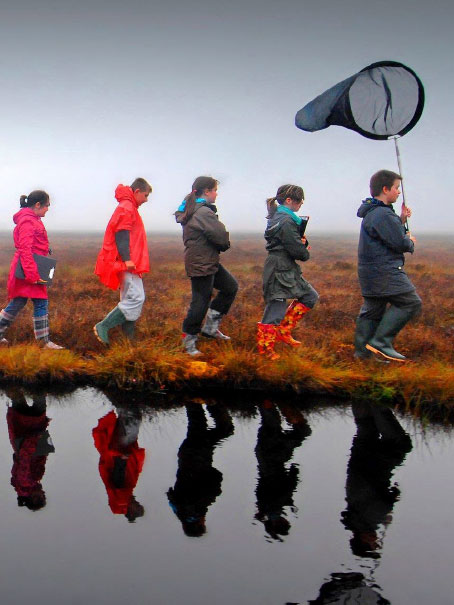
Image 2.1. Blawhorn Moss National Nature Reserve (© Lorne Gill, SNH)
Introduction
The Scottish Government is committed to taking a human-rights-based approach to tackling the challenges posed by climate change. The UN Special Rapporteur’s recent report on climate change and poverty highlighted that the greatest impact of climate change will be felt by those living in poverty, and that climate change also threatens democracy and human rights. The Paris Agreement includes the concept of climate justice, which recognises that the poor and vulnerable at home and overseas are the first to be affected by climate change, yet have done little or nothing to cause the problem.
When people are already vulnerable, climate change can have a compounding effect, worsening overall outcomes, particularly those associated with health and wellbeing. Whilst everyone’s health can be affected by climate change, those who are socially disadvantaged, older, very young or experiencing chronic health problems are less able to cope. This is because these groups are disproportionately more sensitive to climate change impacts; are more exposed to the risk because of the environment they live in and/or, have less ‘adaptive capacity’ – resources to prepare, respond and recover from the impacts of climate change. Location can also be a factor in increasing vulnerability, for example, for those who live in a flood prone area, or those who live in remote, or island communities. Individuals in these locations can be particularly susceptible to extreme weather, which can cause disruption to lifeline transport services.
Where We Are Now
The Scottish Government began work on flood risk and disadvantage in the first Adaptation Programme. In 2015, we published Mapping Flood Disadvantage in Scotland which mapped the communities that were most socially and spatially vulnerable to flooding. Work has been further developed with the Mapping Flood Disadvantage Tool, which was used to inform the second National Flood Risk Assessment (NFRA). Recent research in the area of health includes a ClimateXChange scoping study in 2018, on the risk from overheating in buildings that house vulnerable people in Scotland. NHS National Services Scotland (NHS NSS) has carried out a climate change impact assessment to consider key climate risks for each NHS Board.
The following diagram outlines the structure of this chapter. It is divided into two Sub-Outcomes and sets out the policies that contribute towards this Outcome. The Sub-Outcomes are divided along the themes of vulnerable people and health and social care.
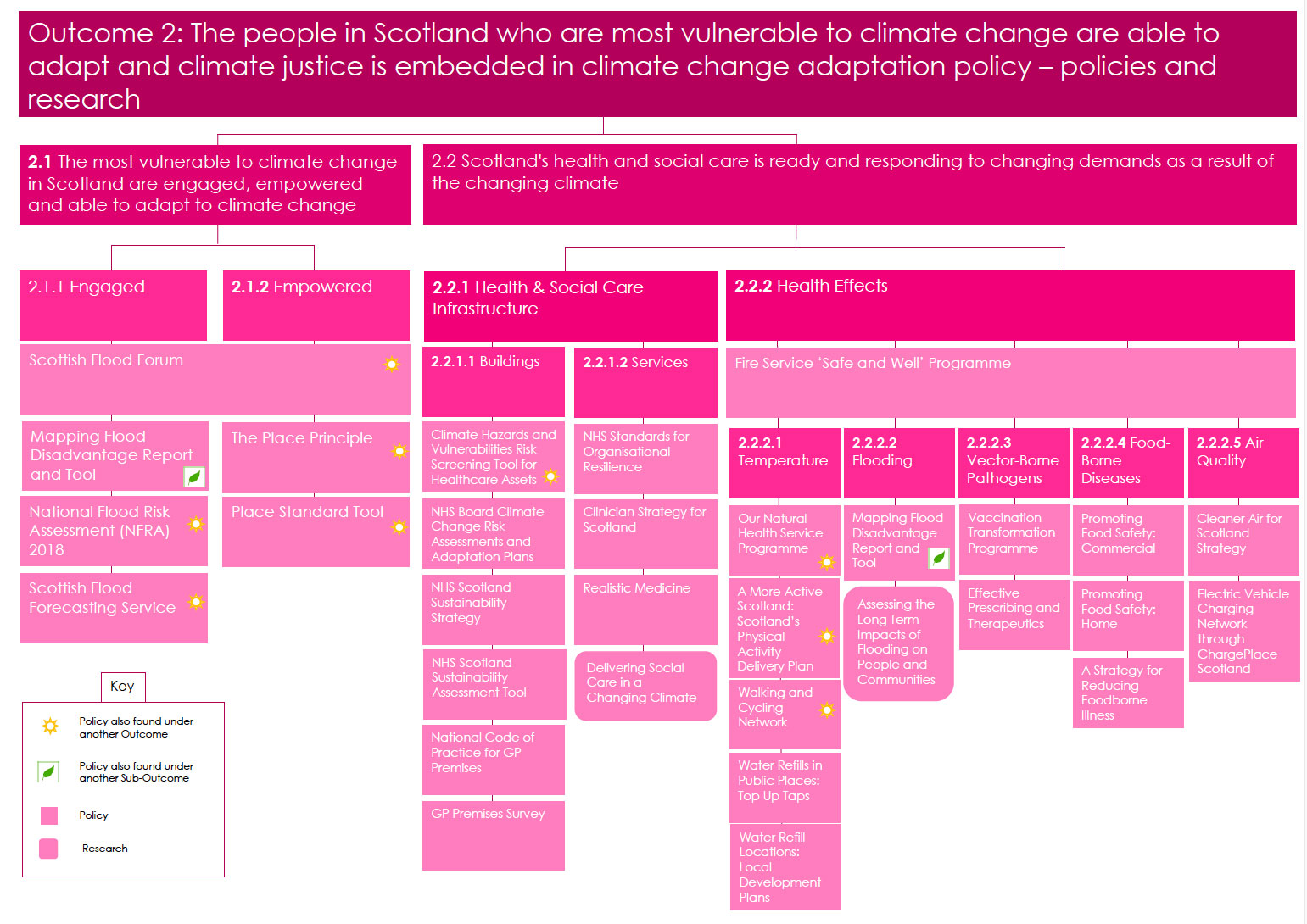
Sub-Outcome 2.1: The most vulnerable to climate change in Scotland are engaged, empowered and able to adapt to climate change
The impacts of climate change can affect anyone, however some people and groups are likely to be more affected than others. Impact depends not only on exposure to a climatic event such as flooding, heatwaves or droughts but also on vulnerability. Drivers of social vulnerability include individual characteristics, such as age and health, but also environmental characteristics, such as the availability of greenspace or quality of housing stock, which can increase or offset exposure to flooding or heat; and social and institutional context, such as levels of income, strength of social networks and the day-to-day practices of institutions, such as care regimes in nursing homes, which affect people’s ability to adapt. Climate change can act as a stress-multiplier, worsening existing problems, as well as creating new ones.
Socially vulnerable groups sensitive to climate impacts.
Very young children – babies and young children face disproportionately high health effects as a result of climate change impacts. Extreme events can be traumatic and potentially lead to developmental impacts.
Older people – older people also tend to be more sensitive to the health effects from climate impacts.
People in poor health or with poor mobility and access – people with existing physical or mental health problems may have a lower capacity to take action.
Tenancy status – some of the worst adapted homes are inhabited by tenants, who are less able to make changes to their homes. They are also less likely to have adequate insurance and often have less information about risk factors like flooding.
Social isolation – people who are socially isolated may not receive the help they need during flooding or extreme weather events as they lack the necessary support networks.
People on low incomes – income is a strong determinant for people’s ability to respond to and recover from climate change impacts.
Location – where people live can be a factor that increases sensitivity to climate change impacts. Those who live in flood prone areas, or remote, or island communities can be particularly susceptible to extreme weather events. More frequent flood events, storms and strong winds can cause damage and disruption to lifeline services.
The Scottish Government works to tackle poverty and social justice in a number of ways. We want Scotland to be a place where people are healthier, happier and treated with respect, and where opportunities, wealth and power are spread more equally. Our Fairer Scotland Action Plan sets out 50 fairness actions for this parliamentary term working towards five high level ambitions including: ending child poverty, a strong foundation for all young people, fairer working lives and a thriving third age. By making Scotland a fairer place, we will also improve the adaptive capacity of Scotland’s people.
Cross-Cutting Policies
| Scottish Flood Forum |
|---|
| The Scottish Flood Forum is an independent charity that provides support in the event of flooding and helps establish community resilience for areas at risk of flooding. Their Flood Recovery services always seek to support those in greatest need, influenced by a number of factors including disadvantage. More information on this organisation can be found in Section 1.1. |
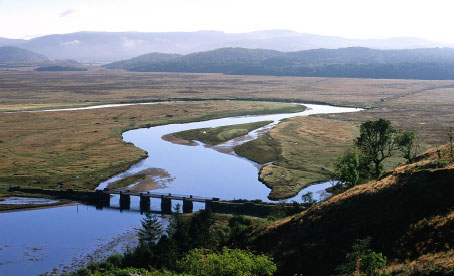
Image 2.2. Main Mhor National Nature Reserve (© Lorne Gill, SNH)
2.1.1 Engaged
The Scottish Government wants the people of Scotland to be aware and informed about the changes that will be required as we adapt to the changing climate. Climate change is complex and can be overwhelming so it is important that people understand how climate change will impact on their everyday lives. It is particularly important for those who are already vulnerable for economic, social or individual reasons, as they are likely to feel the greatest impact. The following policies will help the Scottish population and policy makers to increase their understanding of the impacts of climate change.
| Mapping Flood Disadvantage Report and Tool |
|
|---|---|
| We have undertaken research to identify and map flood disadvantaged neighbourhoods. An interactive map shows the most flood disadvantaged neighbourhoods and their underlying flood vulnerability to help us to better understand the social impacts of flooding at a neighbourhood scale. The outputs are embedded in the National Flood Risk Assessment and inform the flood risk management strategies and local flood risk management plans. The results also support cross-departmental working, identifying priority areas for emergency services, and communicating flood risk issues to local communities. Local authorities, SEPA, the Scottish Flood Forum and others use the tool to target flood risk management actions including community engagement and awareness raising. |
|
| Timeline: Ongoing, to be updated within five years |
Owners: Scottish Government |
| National Flood Risk Assessment (NFRA) 2018 |
|---|
| In 2018, SEPA published the second NFRA. This gives us the clearest picture yet of flood risk in Scotland, embedding climate change and a comprehensive range of social, environmental and economic impacts into a single assessment. More information on this policy can be found in Section 1.2.3. |
| Scottish Flood Forecasting Service |
|---|
| As flood risk increases due to climate change, the forecasting service ensures that forecasting and warning information is available to the public and emergency responders. More information on this policy can be found in Section 1.1.1. |
2.1.2 Empowered
The Scottish Government is committed to supporting people to act for themselves and have their voices heard in the planning and delivery of services including climate change adaptation. We want to support people, and particularly those most vulnerable to climate change, to take action to adapt to the changing climate. The policies below set out how we will empower people to adapt to the changing climate.
| The Place Principle |
|---|
| We will promote the adoption of the Place Principle across Scotland, to ensure that places are shaped by the way resources, services and assets are directed and used by the people who live in and invest in them. The Place Principle calls on all those responsible for providing services and looking after assets in a place to work and plan together, and with local communities, to improve the lives of people, support inclusive and sustainable growth and create more successful places that will be capable of adapting to climate change. More information on this principle can be found in Section 1.1.2. |
| The Place Standard Tool |
|---|
| The Place Standard is a tool to evaluate the quality of a place and can help communities, public authorities and industry to work together to create places that support a high quality of life. By providing an equal opportunity for individuals to consider which elements of place are most important to them, and which could be improved in their local area, the tool can give a voice to those who often do not get heard. As part of an ongoing improvement programme, work will focus on engaging diverse and seldom heard groups, helping to capitalise on opportunities for place-based approaches to support climate justice and climate change adaptation. More information on this policy can be found in Section 1.1.2. |
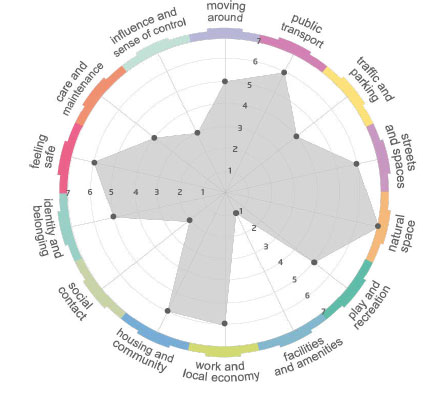
Image 2.3. Place Standard Tool Visualisation
Sub-Outcome 2.2: Scotland's health and social care is ready and responding to changing demands as a result of the changing climate
Climate change will pose new risks to the provision of health and social care in Scotland and amplify existing risks. It will have the greatest impact on those who are already vulnerable. Health and social care systems face climate change risks through impacts to human health and wellbeing from temperature, flooding, pathogens and air quality as well as through impacts to the physical infrastructure and provisioning of services.
The buildings that are used for health and social care need to be adaptable as the climate warms and extreme weather becomes more likely. Wetter, warmer winters will have the potential to lead to increased algal and fungal growth in buildings, with consequential effects on those vulnerable to allergy diseases (e.g. asthma) and other respiratory diseases. Warmer summers and more very hot days could increase water and food-borne disease and rodent-borne diseases.
2.2.1 Health and Social Care Infrastructure
The main risks to the infrastructure of health and social care relate to buildings and the provision of services. Higher and lower temperatures, storms, and flooding worsened by climate change can have a detrimental impact on hospitals, care homes and other health and social care buildings. Extreme weather, heat and flooding can all impact on the ability of health and social care providers to give care. These impacts are not only caused by potential disruptions in care regimes, but also increases in health service demands.
2.2.1.1 Buildings
The adaptability of the built environment of the health and social care system are considered in this section. All other non-health and social care related buildings and sites are considered under Section 1.2.3.2.
| Climate Hazards and Vulnerabilities Risk Screening Tool for Healthcare Assets |
|
|---|---|
| A Climate Hazards and Vulnerabilities Risk Screening Tool for Healthcare Assets is being developed for NHS Scotland. The new screening tool – which will complement the existing CCRA Tool (see below) – will provide NHS Boards with a Scotland-wide resource that brings together natural hazard and health-related vulnerabilities to inform NHS Scotland risk assessment and planning processes, including identification of the risk of damage and loss to healthcare assets and sites. The Tool will assist climate change risk assessments at the national and NHS Board level, and inform prioritisation and decision-making for adaptation. |
|
| Timeline: Launched summer 2019 |
Owners: NHS National Services Scotland, NHS Boards |
| NHS Board Climate Change Risk Assessments and Adaptation Plans |
|
|---|---|
| NHS National Services Scotland (NHS NSS) recently undertook an NHS Scotland-wide climate change impact assessment to consider the key climate risks for each NHS Board. This included a flood risk assessment of over 250 NHS sites. Building on these initial studies, NHS NSS have now developed a Climate Change Risk Assessment (CCRA) tool which enables NHS Boards to assess their climate risks and integrate these assessments into resilience planning at each site. The CCRA tool enables Boards to identify mitigating actions, including climate change remedial works where required. Work is now in progress across all NHS Boards to transition from the initial impact assessment to full adaptation plans. |
|
| Timeline: Launched in 2019 |
Owners: NHS National Services Scotland, NHS Boards |
| NHS Scotland Sustainability Strategy |
|
|---|---|
| A new NHS Scotland Sustainability Strategy is being developed that will encompass all aspects of sustainability as they pertain to the NHS. The Strategy is based around the NHS Scotland sustainability brand: “Sustainability Action: Our NHS, Our People, Our Planet” and will provide clear ambitions and actions against 16 areas of focus, including Climate Change Adaptation, Nature and Biodiversity, Greenhouse Gases, and Governance and Policy. The Strategy will also link to the UN Sustainable Development Goals and the Scottish National Performance Framework. |
|
| Timeline: The Strategy will be developed during 2019-20. |
Owners: NHS National Services Scotland, NHS Health Scotland |
| NHS Scotland Sustainability Assessment Tool |
|
|---|---|
| The NHS Scotland Sustainability Assessment Tool (NSAT) enables NHS Scotland Boards to assess their sustainability performance across 16 different areas of focus, including Climate Change Adaptation, Nature and Biodiversity, Greenhouse Gases, and Governance and Policy. The NSAT comprises a series of best practice statements for each area, and NHS Boards are scores against their compliance with these. Each best practice statement can also be tracked back to at least one of the UN Sustainable Development Goals. Going forward, the NSAT will be used to develop sustainability performance management indicators for each Board, and to prioritise action for improvement. |
|
| Timeline: Baseline scores for each NHS Board were established in March 2019. The online NSAT was launched in May 2019. Annual NSAT scores will be reassessed in January of each year. |
Owners: NHS National Services Scotland, NHS Boards |
| National Code of Practice for GP Premises |
|
|---|---|
| Climate change may result in increased damage to buildings as a result of increased rainfall, driving rain and extreme weather events. Practice premises are increasingly perceived as an unwanted liability by potential GP partners; and this has become a barrier to recruitment, retention and retirement. The Scottish Government recognises and supports a long-term shift that gradually moves towards a model which does not presume GPs own their practice premises. The National Code of Practice for GP Premises sets out how the Scottish Government will support a shift, over 25 years, to a new model in which GPs will no longer be expected to provide their own premises. Through a programme of loans and the prioritised assignment of leases Health Boards will take on the responsibility of providing GP premises. These loans can be used to improve the condition of GP premises across Scotland, helping to improve the resilience of primary health care delivery as the climate changes. |
|
| Timeline: 2018-2043 |
Owners: Scottish Government |
| GP Premises Survey |
|
|---|---|
| To understand baseline condition of General Practice premises all premises used to provide General Medical Services by GPs will be surveyed in 2018-19. This will provide the data on the maintenance required in General Practice Premises which NHS Boards will require for their premises plans. This information is essential if NHS Boards are to effectively support practices with premises issues, including the impact of climate change. |
|
| Timeline: October 2018 - May 2019 |
Owners: Scottish Government |
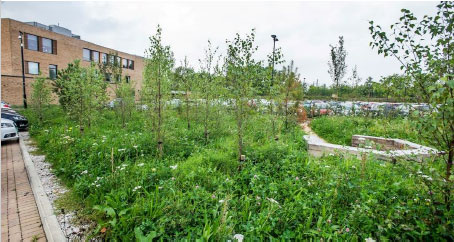
Image 2.4. Multi-functional greenspace at Eastwood Health and Community Care Centre (© Anne Lumb, Green Exercise Partnership)
2.2.1.2 Services
Extreme weather such as floods, storms, cold and hot weather and heatwaves affect the ability of the National Health Service and social care providers to deliver their services, through effects on staff and equipment. The policies and research below set out how the health and social care services are working to adapt to ensure they can continue to deliver their services as the climate changes. How Scotland’s emergency services adapt to climate change will be considered in the Supporting Systems chapter of this Programme.
| NHS Standards for Organisational Resilience |
|
|---|---|
| NHS Scotland’s Standards for Organisational Resilience are designed to support NHS Boards to enhance their resilience. There are 41 standards that cover a range of topics that NHS Boards need to be prepared for including climate change. The Standards specify minimum standards and related measures/performance indicator criteria for resilience. A standard is a statement of an expected level of service that demonstrates delivery of practices acknowledged as safe and effective. Standard 38 sets the minimum standard for NHS resilience to climate change: “The NHS Board shall develop a robust approach towards implementing a range of actions to assure the continuity of quality healthcare services before, during and after extreme weather events.” Detail regarding the measures of the standard/ indicators can be found here. This Standard is used by the Scottish Government Health Resilience Unit to monitor NHS Boards’ preparedness to climate change. |
|
| Timeline: 2019 – 2021 |
Owners: Scottish Government and NHS Boards |
| Clinician Strategy for Scotland |
|
|---|---|
| The Clinician Strategy for Scotland makes proposals for how clinical services need to change in order to provide sustainable health and social care services fit for the future. It lays out a framework to take into account future significant changes to Scotland. A more strategic and sustainable health and social care system will increase the systems resilience to the risks of climate change. |
|
| Timeline: Sets out the vision up to 2025 - 2030 |
Owners: NHS Scotland |
| Realistic Medicine |
|
|---|---|
| The most recent annual report from the Chief Medical Officer for Scotland, Personalising Realistic Medicine, builds upon the previous reports to set the vision for clinical practice change. It aims to reduce harm, waste and unwarranted variation, all while managing risks and innovating to improve. Creating a sustainable health and social care system in Scotland is at the heart of this policy. Being thoughtful about environmental sustainability and effective stewardship of resources, alongside financial and system sustainability is necessary for co-benefits to be achieved. |
|
| Timeline: Fourth annual report published in 2019 |
Owners: NHS Scotland |
Delivering Social Care in a Changing Climate
For the health and social care sector climate change may pose new risks to services and also multiply existing risks. This project has been initiated to provide data on the impacts of climate change relating to delivery of social care itself (Care at Home), as well as in understanding the extent of the risk for social care facilities and the sector’s dependencies on different areas of infrastructure, particularly transport and telecommunications. The study will look at:
- direct impacts on buildings and infrastructure needed for service delivery from extreme weather, rising temperatures and other weather related disruptions,
- indirect impacts from changing demand on services as a result of premature deaths or increases in certain diseases as a result of temperature or precipitation.
Research
2.2.2 Health Effects
The changing climate could have both positive and negative impacts on human health. More extreme weather will increase the risk of flooding, heatwaves, changes to air quality, and potentially new pathogens. These events, in turn, can lead to negative health effects, including heat-related illness, respiratory infections due to damp and air quality changes, and potentially illnesses related to new pathogens. Climate change and associated severe weather events do and will continue to affect population health in Scotland both directly and indirectly.
Cross-Cutting Policies
| Fire Service ‘Safe and Well’ Programme |
|
|---|---|
| The Scottish Fire and Rescue Service (SFRS) is working in collaboration with partners and communities to ensure collective resources jointly tackle issues related to inequality and protect those citizens at greatest risk. This is particularly important as individuals with pre-existing vulnerabilities are most at risk from climate change impacts. The SFRS currently offer everyone in Scotland a free Home Fire Safety Visit, and is particularly focused on delivering this to the most vulnerable citizens. SFRS staff are alert during these visits to the signs of loneliness, fragility, potential slips, trips and falls, signs of drug addiction and / or alcoholism and general health risks within the homes of our most vulnerable Scottish citizens. A lot of these risks occur more frequently with older people, however they can be equally prevalent across other age groups. Over the next twenty years there will be a significant rise in the proportion of over 65s in Scotland. This will generate new demands as SFRS seek to support the population to age well in safe and resilient communities. As part of the SFRS Transformation Programme, the Service is also developing its ‘Safe and Well’ project. This project will see an expansion of the Home Fire Safety Visit programme to incorporate wider health and social care considerations. Working with a range of partners, both internal and external, the project will include the development of bespoke ICT systems to record activity and provide referrals directly to partners. The overall aim of this project is to ensure people live safely in their homes, reducing not only the risk of fire, but other incidents of unintentional injury. |
|
| Timeline: April 2018 - March 2021 |
Owners: Scottish Fire and Rescue Service |
2.2.2.1 Temperature
Increased mean annual temperatures may cause both positive and negative effects for human health in Scotland. The frequency of heatwaves is projected to increase in the future as a result of climate change. Hot summers are expected to become more common[3]. In Scotland, heat-related mortality is expected to increase from 38 to between 70 and 281 excess deaths per year (considering a population of 5.4 million), under the UKCP09 medium emissions scenario[4]. People living in neighbourhoods with less greenspace, especially urban areas, may experience more extreme impacts from events like heatwaves, due to phenomenon like the urban heat island effect.
Although warmer summers come alongside a risk of dangerous heat waves, a projected rise in mean annual temperature may lead to some healthier outcomes due to the potential for increased outdoor activities. Some of the policies in this section relate to making the most of the potential for increased outdoor activity, which would have positive outcomes on both physical and mental health.
Higher temperatures may also lead to a reduced reliance on heating, helping to alleviate the detrimental effects of fuel poverty. Cold-related human mortality is the biggest weather-related issue currently in Scotland, with between 2,590-3,890 excess deaths per year[5]. Many of the predictions released in the UK Climate Projections 2018 show warmer winters for Scotland, which could reduce the risk of cold-related deaths, particularly for those who have trouble heating their homes. Although the potential for warmer weather throughout the year may lead to some better health outcomes, extreme weather events are also likely to increase in frequency and intensity.
| Our Natural Health Service Programme |
|
|---|---|
| The Natural Health Service supports the health sector to embrace green exercise as part of policy and practice. This will see nature-based health programmes used as part of health promotion and improvement, and encourage healthier lifestyle behaviours. Changes to Scotland’s climate may support this programme as leisure and other outdoor activities may be taken up autonomously by people as the climate warms. |
|
| Timeline: To 2024, complete current demonstration projects by 2022 and embed good practice into NHS policy. |
Owners: SNH, NHS |
| A More Active Scotland: Scotland’s Physical Activity Delivery Plan |
|
|---|---|
| The Physical Activity Delivery Plan sets out actions being taken to encourage and support people in Scotland to be more active, more often. It specifically helps people from inactive, disadvantaged and other under-represented groups enjoy the well-being benefits from being outdoors in nature. Changes to Scotland’s climate may support this programme as leisure and other outdoor activities may be taken up by people as the climate warms. |
|
| Timeline: To 2024, work to increase participation in outdoor recreation at the same rate as the last five years, with a particular focus on currently under-represented groups. |
Owners: Scottish Government, SNH |
| Walking and Cycling Network |
|---|
| This network will close key gaps, upgrade connecting routes, link to public transport and promote shared use of paths to encourage active travel and enjoyment of Scotland’s natural landscapes. More information on this policy can be found in Section 5.2.2. |
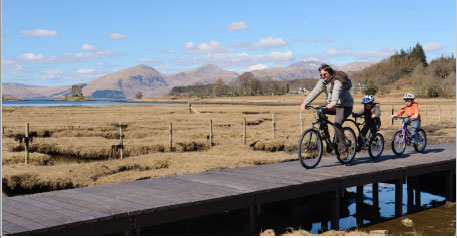
Image 2.5. Sustrans Route 75, Oban to Fort William (© Lorne Gill, SNH)
| Water Refills in Public Places: Top Up Taps |
|
|---|---|
| Scottish Water launched its ‘Your Water, Your Life’ campaign, which aims to increase customers’ appreciation of Scotland’s tap water and reduce the use of single-use plastic bottles. Ongoing customer surveys show the campaign is successfully engaging people on both objectives. By April 3 2019, Scottish Water had 10 Top Up Taps in the ground and working. They plan to install 70 taps in locations across Scotland by March 2021. Increasing the availability of tap water can help support Scotland’s population adapt to the changing climate by providing a free, accessible way to stay hydrated, particularly important during hot weather. |
|
| Timeline: Top Up Taps in all Local Authority areas by March 2021. |
Owners: Scottish Water, Scottish Government |
| Water Refill Locations: Local Development Plans |
|
|---|---|
| The Planning (Scotland) Act 2019 includes a requirement that local development plans prepared by planning authorities in Scotland are to include a statement of the authority’s policies and proposals for the provision of water refill locations. |
|
| Timeline: To be included in the new generation of Local Development Plans once the relevant provisions of the Act come into force. |
Owners: Local authorities, planning authorities, Scottish Government |
2.2.2.2 Flooding
Whilst flooding is normally considered as a risk to homes, businesses and infrastructure it can also become a health hazard. When flooding occurs, waste water from sewer systems can back up into houses through drain pipes. Sewer flooding can be caused by prolonged or heavy rainfall, typically in the form of severe localised storms that can overwhelm the sewer system. The increase in severe weather episodes such as flooding may also result in an increase in mental ill health due to distress of displacement, loss of personal possessions and financial losses.
There are a number of environmental, social and personal characteristics that may increase someone’s vulnerability to flooding. People living in neighbourhoods with less greenspace, especially urban areas, may experience more extreme impacts from events like flooding. People who have lived in an area for a short time may be unaware of past floods and the potential for future flooding. Social isolation may mean that people do not get the help they need.
| Mapping Flood Disadvantage Report and Tool |
|
|---|---|
| We have undertaken research to identify and map flood disadvantaged neighbourhoods. An interactive map shows the most flood disadvantaged neighbourhoods and their underlying flood vulnerability to help us to better understand the social impacts of flooding at a neighbourhood scale. More information on this policy can be found in Section 2.1.1. |
|
| Timeline: Ongoing, to be updated within five years |
Owners: Scottish Government |
Assessing the Long Term Impacts of Flooding on People and Communities
In 2016 the Scottish Government commissioned a 3 year research project to better understand the long term impacts of flooding for individuals, families and communities. The study follows individuals affected by the 2015-16 floods in Aberdeenshire over a three year period and their journey recovering from the floods. This will help us understand what types of support and advice people and communities need at different stages of a long-term recovery.
Research
2.2.2.3 Vector-Borne Pathogens
The impact of climate change on the distribution of vector-borne pathogens is uncertain. The only significant vector-borne parasite of humans currently established in the UK is Lyme disease, transmitted by Ixodes ricinus (a species of tick). As the climate changes, the incidence of Lyme disease may shift but other factors such as agriculture, land use, tourism and wildlife populations will also be major factors. There is very limited research regarding other vector-borne pathogens however, risk from disease from current vectors, including mosquitoes, is considered very low currently. The UK Climate Change Risk Assessment suggests that it is unlikely that the UK will become habitable for other vectors of disease before the 2050s.
| Vaccination Transformation Programme |
|
|---|---|
| Vaccinations will progressively move away from a model based on GP delivery to one based on NHS Board delivery through dedicated (and thus more resilient) teams. The Vaccinations Transformation Programme is reviewing and transforming how we deliver vaccinations in Scotland. Delivery will move away from the current position of GP practices being the preferred provider of vaccinations on the basis of national agreements. This will only happen where it is safe to transfer services. Underserved populations experience inequalities in health and are often under vaccinated, being at greater risk of vaccine-preventable diseases. During the Vaccination Transformation Programme transition, it is important that vaccination coverage is maintained or improved, and the inequalities gap closes further. This new model will allow swifter adoption of any vaccination programmes without national negotiation ensuring the NHS is able to respond to potential new or increased risks as a result of the changing climate. |
|
| Timeline: 2017-2021 |
Owners: Scottish Government |
| Effective Prescribing and Therapeutics |
|
|---|---|
| The Effective Prescribing and Therapeutics Branch exists to ensure delivery of safe and effective prescribing and use of medicines, within NHS Scotland. The aim of this delivery programme is to make more effective use of therapeutic resources. More effective use can help reduce resource consumption that contributes to climate change. Strategic prescribing and therapeutics usage supports adaptation to the potential new or increased risks that can come as a result of climate change. |
|
| Timeline: Ongoing |
Owners: NHS Scotland |
2.2.2.4 Food-Borne Disease
As the climate changes, it is possible that current food monitoring programmes and interventions aimed at identifying and preventing food safety risks are inadequate to deal with the state of future threats through food-borne diseases. Overall, the high level of current regulation regarding food safety provides us with a high adaptive capacity. Policies in this area are also being considered in the International Chapter under Sub-Outcome 7.1.1.
| Promoting Food Safety: Commercial |
|
|---|---|
| Food Standards Scotland (FSS) engages with food businesses across Scotland to improve understanding of current and emerging food safety risks, including those that may be exacerbated by climate change, and produces guidance to support effective food safety management in all areas of food production and service (from farm to fork). |
|
| Timeline: Ongoing |
Owners: Food Standards Scotland |
| Promoting Food Safety: In the Home |
|
|---|---|
| Food Standards Scotland (FSS) raises awareness to the consumer of the importance of undertaking good food hygiene practices in the home through targeted media campaigns and a range of consumer engagement activities. FSS undertakes annual surveys of consumer attitudes and behaviours with respect to food safety and healthy eating. This provides FSS with an up to date understanding of food safety knowledge and supports the targeting of campaigns aimed at raising awareness and promoting behaviour change. FSS’s role in supporting consumers to understand food safety risks and protect themselves from foodborne illness considers any risks that may be exacerbated by climate change. |
|
| Timeline: Ongoing |
Owners: Food Standards Scotland |
| A Strategy for Reducing Foodborne Illness |
|
|---|---|
| This strategy is supported by a research programme aimed at improving understanding of the transmission of contaminants in the Scottish food chain, and the impacts of foodborne diseases such as Shiga toxin producing E. coli and Campylobacter on the Scottish population. Although this work is not specifically designed to assess the impact of climate change on food safety and quality, it supports the identification of emerging risks associated with changes in food production environments and the development of mitigation strategies. |
|
| Timeline: Ongoing |
Owners: Food Standards Scotland |
2.2.2.5 Air Quality
Clean air is essential for our health and wellbeing, and helps to protect the environment as a natural asset. Whilst we have made great strides towards tackling air pollution in Scotland over recent years, it must be acknowledged that there are still areas of poorer air quality in many of our towns and cities. The impacts of poor air quality are not distributed evenly across the population: it is the most vulnerable members of society – the elderly, the very young and those with cardiovascular and respiratory conditions – who bear the largest burden. Changes in the climate will also impact on air quality; increases in temperature may affect the formation of ozone, increasing the frequency and severity of summer smog events.
| Cleaner Air for Scotland Strategy |
|
|---|---|
| A review of the Cleaner Air for Scotland Strategy is due for completion at the end of 2019. Low Emission Zones will set an environmental limit on certain road spaces, allowing access to only the cleanest vehicles. We will work in partnership with local authorities and regional transport partnerships to deliver Low Emission Zones that are well designed to consistent national standards. The National Low Emissions Framework document will set the framework within which Low Emissions Zones are introduced and will be published in line with the commitments of the Cleaner Air for Scotland strategy. |
|
| Timeline: Glasgow – 31 Dec 2018 Aberdeen, Dundee and Edinburgh – by end 2020 |
Owners: Scottish Government |
| Electric Vehicle Charging Network through ChargePlace Scotland |
|
|---|---|
| Electric vehicles will not only help reduce greenhouse gas emissions and tackle climate change, but also help improve local air quality and therefore public health and wellbeing. Transport Scotland is supporting increased uptake of electric vehicles by:
Delivery of this policy will be supported by changes to the Scottish planning system, such as no longer needing planning permission for on-street charging points. |
|
| Milestones/Timeline: To 2022 |
Owners: Transport Scotland |
Adaptation Behaviours
Adapting to climate change requires action from across all areas of society. The Scottish Government, local government, public bodies, the private sector, third sector, communities and individuals all have a role to play. Individuals can take action to help prevent some of the negative health effects that can result from climate change risks to factors such as air quality, high temperatures and severe weather. Those who are most vulnerable to climate change are encouraged to take additional action, with the rest of society supporting them to adapt.
Individual Behaviours
1. Stay safe in the sun. When enjoying the sun, people are encouraged to cover up with suitable clothing and sunglasses, avoid burning, take care with children and use at least SPF 15 sunscreen with a four star rating. More information can be found on the NHS Inform website.
2. Be aware of pollen and pollution levels. Changing weather patterns may impact pollen count and pollution levels which can exacerbate some existing health conditions. When high levels are forecasted, those who could be more vulnerable such as children and those with respiratory problems are encouraged to have the medication they need.
Societal Behaviours
1. If a severe weather event is forecast people are encouraged to check on vulnerable neighbours and help them prepare. After the event, they are asked to make sure that they are safe and help them make arrangements for any repairs.
2. When extreme weather unexpectedly results in a carer being separated from a cared-for person, an emergency plan ensures that the relevant people have all the necessary information to step into a caring role temporarily.
Monitoring and Evaluation: Outcome 2
Monitoring and Evaluation is integral to the outcomes-based approach which encourages consideration at all stages of adaptation policy development. Further information including a general introduction to the framework, and a description of the foundation and principles can be found in the monitoring and evaluation introduction and Annex 3 respectively.
Key sources of existing monitoring evidence for Outcome 2 include: the Resilient Communities Strategic Framework, the Scottish Household Survey, NHS Scotland, and Health Protection Scotland. There is currently limited data available for some themes, but by identifying what we need to measure not just what we know we can, the framework highlights monitoring gaps which will be filled as more data and associated monitoring arrangements are developed.
Monitoring the Adaptation Process (‘What are we doing?’) The themes set out the structure to monitor the implementation of and output from adaptation policies and actions which support the Outcome. Indicators will include metrics of, for example: access to information, coverage of health impact monitoring, and the use of place-based approaches.
Monitoring the Sub-Outcomes (‘Is it working?’) The Sub-Outcome monitoring themes highlight the key components of each Sub-Outcome and provide the structure for evaluating progress. Indicators will include metrics of, for example: public awareness and household resilience in vulnerable groups, organisational resilience, and climate-linked health impacts.
Monitoring the outcome Monitoring at this high level will directly link the outcome to wider government policy and the National Performance Framework by utilising relevant indicators already associated with these high-level monitoring frameworks.
| National Performance Framework Indicators |
Sustainable Development Goals Indicators |
|---|---|
|
|
Monitoring and Evaluation Structure: Outcome 2
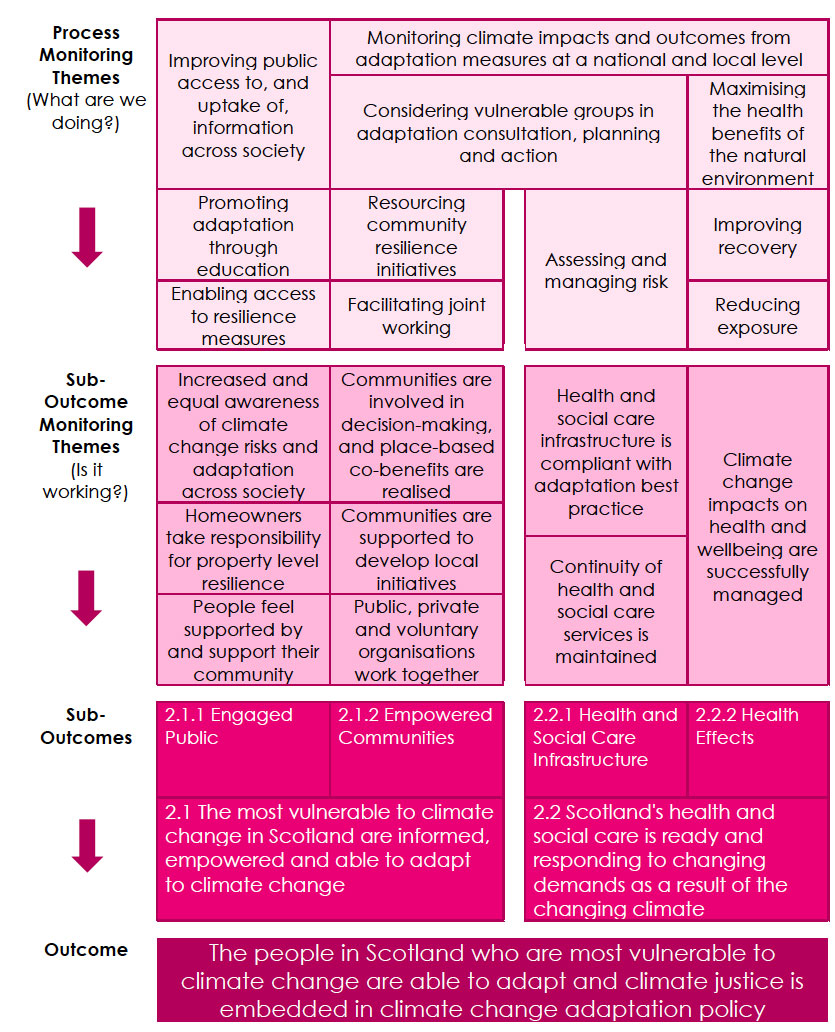
UK Climate Change Risk Assessment: Associated Risks
The UK Climate Change Risk Assessment risks that will be addressed by the policies presented in Outcome 2 are set out below:
| PB1: |
PB4: |
PB9: |
| PB10: |
PB11: |
PB12: |
Contact
Email: roddy.maclean@gov.scot
There is a problem
Thanks for your feedback